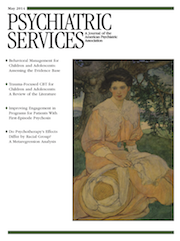Dis-ease and Disease
To the Editor: I am writing to comment on the brief report by Schiffman and colleagues in the February issue (1). There are several aspects of the report that I find problematic.
The first problem is rather straightforward: What is the value of comparing individuals and families at such vastly different developmental levels, with children who are eight years old and those who are over 30? There are marked differences in development as well as in family and social context between the two groups that make comparison irrelevant. This leads to the question of the significance of any of the findings about families of these children. And we didn’t need this research to demonstrate that parents with minor children feel a greater weight of responsibility for managing their disturbed children than do parents of much older children and that the younger parents are more involved in their child’s treatment.
The second problem, however, is more worrisome. It arises because the authors used the term “mental illness” without defining it. Are there diagnostic labels that signify mental illness? And if so, what diagnoses would they be?
What is mental illness? This has become perhaps an even more controversial topic, with the publication of DSM-5 and the some of the reactions to it. I must admit that I come down on the side of Allen Frances (2), who notes that the inclusiveness of diagnostic criteria makes it possible for almost any behavior to engender a diagnosis. Is having a diagnosis also having a mental illness?
Frances’ argument takes me on the mental journey from discomfort (or dis-ease) to disease and to illness. Dis-ease is a common daily experience for many of us—for example, when we struggle with a situation that is difficult to manage, have a disagreement, or experience financial, employment, or housing problems. For young children, dis-ease might arise in response to social problems and learning difficulties. A major facilitator of the transition from dis-ease to disease is medication. If there is a medicine to ease the dis-ease, surely it must really be a disease—an illness. The pharmaceutical companies are enthusiastic participants in this process, but so are we—the prescribers and the consumers.
In failing to define the “mental illness” of their research subjects, Schiffman and colleagues leave me with the uncomfortable feeling that children in this study were labeled as mentally ill when, in fact, they may be suffering from dis-ease related to growing up and developing. Now they and their families have these labels and the burdens of “mental illness.” If illness is defined as having a diagnosis or a “dis-ease” that may respond to a medication, many of these parents and their children may be being seriously misguided in thinking that they have mental illness and perhaps not getting the helpful guidance for their dis-ease.
People suffer. Medication may help to alleviate suffering. However, dis-ease is a part of living, and we need to be careful about not making it into illness and thus imposing another layer of suffering on both patient and family.
1 : Differences between parents of young versus adult children seeking to participate in Family-to-Family psychoeducation. Psychiatric Services 65:247–250, 2014Link, Google Scholar
2 : Saving Normal. New York, HarperCollins, 2013Google Scholar



